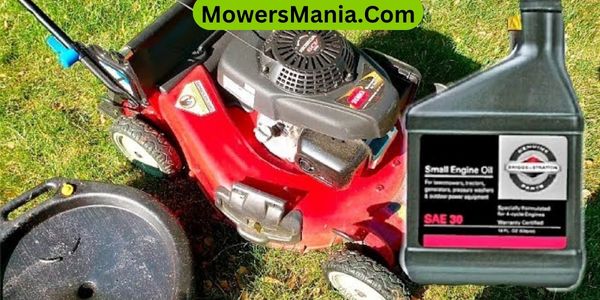You’re ready to give your lawn mower some TLC, and that starts with the right amount of oil. Understanding how much oil your lawn mower needs is crucial for its performance and longevity.
In this article, we’ll guide you through the importance of lawn mower oil, how to check and change the oil, and tips for maintaining optimal performance.

Get ready to keep your lawn mower running smoothly with the right amount of oil.
Importance of Lawn Mower Oil
To ensure proper lubrication and protection of your lawn mower’s engine, using the correct type and amount of oil is essential.
The oil in your lawn mower serves as a lubricant to reduce friction between moving parts, which in turn minimizes wear and tear on the engine.
It also helps to dissipate heat, keeping the engine cool during operation. Without the right amount of oil, the engine can overheat and potentially seize up, causing irreparable damage.
Using the appropriate oil for your specific lawn mower model is crucial. Different engines require different types of oil, such as SAE 30, 10W-30, or synthetic oil.
Using the wrong type of oil can lead to poor lubrication, increased engine wear, and potential malfunctions. Additionally, using too much or too little oil can also have detrimental effects on your engine’s performance and longevity.
Regularly checking and changing the oil in your lawn mower is a simple yet crucial maintenance task. It ensures that your engine continues to run smoothly and extends its lifespan.
Neglecting this important aspect of lawn mower care can result in costly repairs or the need for premature replacement.
Therefore, always prioritize the proper type and amount of oil for your lawn mower to keep it running at its best.
Understanding Oil Capacity
The oil capacity of your lawn mower is a crucial specification that directly impacts its performance and longevity. Understanding the oil capacity of your lawn mower is essential for maintaining its optimal functioning.
Here are some key points to consider:
- Manufacturer’s Recommendation: Always refer to the lawn mower’s manual or the manufacturer’s guidelines to determine the specific oil capacity required for your mower. Different models may have varying oil capacity requirements, so it’s important to adhere to the manufacturer’s recommendations.
- Overfilling vs. Underfilling: Both overfilling and underfilling the oil can have detrimental effects on the lawn mower’s engine. Overfilling can lead to excessive pressure within the engine, potentially causing leaks or other damage. On the other hand, underfilling can result in inadequate lubrication, leading to increased friction and wear.
- Regular Checks: It’s advisable to regularly check the oil level in your lawn mower to ensure it’s within the recommended capacity. This simple maintenance task can significantly impact the longevity and performance of your lawn mower. Regular oil level checks can help prevent potential engine issues and prolong the life of your mower.
Checking Oil Level

You should regularly check the oil level in your lawn mower to ensure it is within the recommended capacity, thus maintaining optimal functioning and preventing potential engine issues.
To check the oil level, follow these simple steps:
- Park on level ground: Ensure the lawn mower is on a flat, level surface before checking the oil level to get an accurate reading.
- Locate the dipstick: The oil dipstick is typically located near the engine and is often marked with a brightly colored handle for easy identification.
- Remove and clean the dipstick: Pull out the dipstick, wipe it clean with a cloth, reinsert it all the way in, and then pull it out again to check the oil level.
- Check the oil level: The dipstick has markings indicating the minimum and maximum oil levels. The oil should fall within this range. If it’s low, add the recommended oil for your mower type.
- Reinsert the dipstick: After checking the oil level, securely reinsert the dipstick to prevent any contaminants from entering the engine.
| Step | Description |
|---|---|
| Park on level ground | Ensure the lawn mower is on a flat, level surface. |
| Locate the dipstick | Find the oil dipstick, usually near the engine. |
| Remove and clean the dipstick | Pull it out, wipe it clean, reinsert, and then pull it out again to check the oil level. |
| Check the oil level | Ensure the oil level falls within the designated range on the dipstick. |
| Reinsert the dipstick | Securely reinsert the dipstick after checking the oil level to prevent contaminants from entering. |
Changing the Lawn Mower Oil
When changing the lawn mower oil, ensure you use the correct type and quantity for optimal engine performance.
Follow these steps for a smooth oil change process:
- Warm up the Engine: Before changing the oil, run the lawn mower for a few minutes to warm up the oil. This will help it flow out more easily when draining.
- Drain the Old Oil: Locate the oil drain plug underneath the mower and place a container beneath it to catch the old oil. Unscrew the drain plug and allow the oil to fully drain out.
- Replace the Oil Filter: If your lawn mower has an oil filter, it’s a good idea to replace it when changing the oil. This helps to ensure that the new oil remains clean and free of debris.
Following these steps will help maintain your lawn mower’s engine in optimal condition, ensuring it operates efficiently and effectively.
Choosing the Right Oil Type
Selecting the right oil type for your lawn mower is crucial for maintaining optimal engine performance and longevity.
Using the wrong oil can lead to increased wear and potential damage to the engine. When choosing oil for your lawn mower, it’s important to consider the viscosity, additives, and whether to use conventional or synthetic oil.
| Oil Type | Viscosity | Additives |
|---|---|---|
| Conventional | SAE 30 or 10W-30 | Detergents, dispersants |
| Synthetic | 5W-30 or 10W-30 | Enhanced lubrication, |
| resistance to breakdown |
Conventional oils, such as SAE 30 or 10W-30, are suitable for standard operating conditions and moderate temperatures.
They contain detergents and dispersants to keep the engine clean and minimize deposits. On the other hand, synthetic oils like 5W-30 or 10W-30 offer enhanced lubrication and resistance to breakdown, making them ideal for extreme temperatures and heavy use.
Consider the manufacturer’s recommendations and the climate in your area when choosing between conventional and synthetic oil for your lawn mower.
Maintaining Oil for Optimal Performance

To maintain optimal performance, regularly check the oil level and condition in your lawn mower engine. Proper maintenance of the oil is crucial for the smooth operation and longevity of your mower.
Here are a few essential tips for maintaining the oil for optimal performance:
- Check Oil Level: Before each use, ensure that the oil level is within the recommended range. Low oil levels can lead to increased friction and overheating, potentially causing damage to the engine.
- Change Oil Regularly: Follow the manufacturer’s guidelines for oil change intervals. Over time, oil becomes contaminated with dirt and debris, losing its lubricating properties. Regular oil changes ensure that the engine is properly lubricated for optimal performance.
- Use High-Quality Oil: Invest in high-quality oil specifically designed for small engines. Quality oil helps reduce friction, minimizes wear and tear, and improves overall engine performance.
Tips for Oil-Related Troubleshooting
To address potential oil-related issues, start by assessing the color and consistency of the oil in your lawn mower’s engine. Proper troubleshooting can help you identify and resolve common oil-related problems.
Here are some tips to help you troubleshoot oil issues in your lawn mower:
| Problem | Solution |
|---|---|
| Dirty or Contaminated Oil | Drain the old oil and replace it with fresh, clean oil. Ensure the oil filter is also clean or replace it. |
| Low Oil Level | Top up the oil to the recommended level using the type of oil specified in the lawn mower’s manual. |
| Oil Leaks | Check for loose or damaged connections, gaskets, or seals. Tighten or replace as needed to stop leaks. |
| Milky or Foamy Oil | This may indicate water or fuel contamination. Have a professional inspect and address the issue. |
Frequently Asked Questions [FAQs]
Can I Use Cooking Oil or Other Types of Oil in My Lawn Mower Instead of Motor Oil?
Yes, you can’t use cooking oil or other types in your lawn mower instead of motor oil. It’s important to use the right oil to ensure proper lubrication and performance of your mower’s engine.
How Often Should I Change the Oil in My Lawn Mower?
You should change the oil in your lawn mower every 25 hours of use or once a season. Regular oil changes help maintain engine performance and prolong the life of your mower. Follow the manufacturer’s guidelines for your specific model.
What Happens if I Overfill or Underfill the Oil in My Lawn Mower?
If you overfill the oil in your lawn mower, it can lead to engine damage, while underfilling can cause insufficient lubrication and potential overheating. Always follow the manufacturer’s guidelines for the correct oil level.
Is There a Specific Way to Dispose of Old Lawn Mower Oil?
When disposing of old lawn mower oil, you should take it to a recycling center or hazardous waste facility. Never pour it down the drain or onto the ground. It’s important to handle and dispose of oil responsibly.
Are There Any Additives or Supplements That Can Improve the Performance of Lawn Mower Oil?
To improve lawn mower oil performance, consider using additives or supplements recommended by the manufacturer. Always follow the guidelines in the owner’s manual. Keep in mind that using the wrong additives can harm the engine.
Conclusion
So, now you know how much oil your lawn mower takes. Remember to regularly check and change the oil to keep your mower running smoothly.
Choosing the right oil type and maintaining the oil level are crucial for optimal performance.
If you experience any issues with your lawn mower related to oil, refer to the troubleshooting tips provided to help resolve the problem.
Keep your lawn mower well-oiled and it will serve you well.



